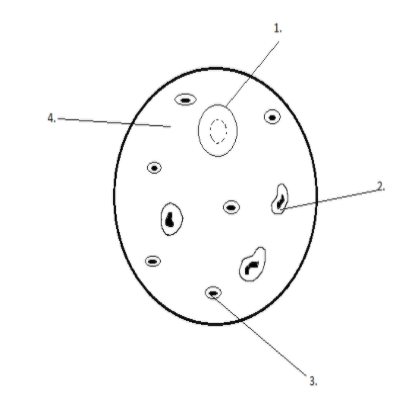
Given below is a diagram of a smear of human blood. Study the same and answer the questions that follow
a. Name the parts 1,2,3,4 indicated by the lines.
b. Mention two structural differences between labeled parts 1 and 2.
c. What are the main functions of the parts labeled 1,2 and 3 respectively?
d. What is the lifespan of the part labeled 1?
e. Name a soluble protein found in 4 which helps in the clotting of blood.


Answer
474.3k+ views
Hint: The blood smear of humans would contain blood plasma, red blood cells, white blood cells and platelets. The red blood cells are circular in shape and are enucleated. The white blood cells are irregular in shape but have nucleus present inside them. While the platelets are the blood cells which are much smaller in size.
Complete answer: To solve the question, we must first know about the blood plasma and the various blood cells.
The answer to question a. is as follows
1. Red blood cell
2. White blood cell
3. Platelet
4. Blood Plasma
Answer b. The structural differences between labeled parts ‘1’ and ‘2’ are as follows:
Answer c. The main functions of RBCs, WBCs and platelets are:
Red Blood Cell (RBC)- They carry oxygen from the heart to the cells located at different parts of the body. They also carry the metabolic wastes from the cells so that they can be excreted out of the body.
White Blood Cells (WBC)- They provide immunity to the body. They prepare the body to fight against various diseases.
Platelets- They help in blood clotting and prevent excess loss of blood from the body.
Answer d. The life span of red blood cells is 115 days approximately.
Answer e. The soluble protein present in plasma which helps in blood clotting is fibrinogen.

Note: The red blood cells should not be confused with the white blood cells. The red blood cells are enucleated while the white blood cells contain a prominent nucleus.
Complete answer: To solve the question, we must first know about the blood plasma and the various blood cells.
The answer to question a. is as follows
1. Red blood cell
2. White blood cell
3. Platelet
4. Blood Plasma
Answer b. The structural differences between labeled parts ‘1’ and ‘2’ are as follows:
Answer c. The main functions of RBCs, WBCs and platelets are:
Red Blood Cell (RBC)- They carry oxygen from the heart to the cells located at different parts of the body. They also carry the metabolic wastes from the cells so that they can be excreted out of the body.
White Blood Cells (WBC)- They provide immunity to the body. They prepare the body to fight against various diseases.
Platelets- They help in blood clotting and prevent excess loss of blood from the body.
Answer d. The life span of red blood cells is 115 days approximately.
Answer e. The soluble protein present in plasma which helps in blood clotting is fibrinogen.

Note: The red blood cells should not be confused with the white blood cells. The red blood cells are enucleated while the white blood cells contain a prominent nucleus.
Recently Updated Pages
Master Class 11 Accountancy: Engaging Questions & Answers for Success

Glucose when reduced with HI and red Phosphorus gives class 11 chemistry CBSE

The highest possible oxidation states of Uranium and class 11 chemistry CBSE

Find the value of x if the mode of the following data class 11 maths CBSE

Which of the following can be used in the Friedel Crafts class 11 chemistry CBSE

A sphere of mass 40 kg is attracted by a second sphere class 11 physics CBSE

Trending doubts
Define least count of vernier callipers How do you class 11 physics CBSE

The combining capacity of an element is known as i class 11 chemistry CBSE

Proton was discovered by A Thomson B Rutherford C Chadwick class 11 chemistry CBSE

Find the image of the point 38 about the line x+3y class 11 maths CBSE

Can anyone list 10 advantages and disadvantages of friction

Distinguish between Mitosis and Meiosis class 11 biology CBSE




